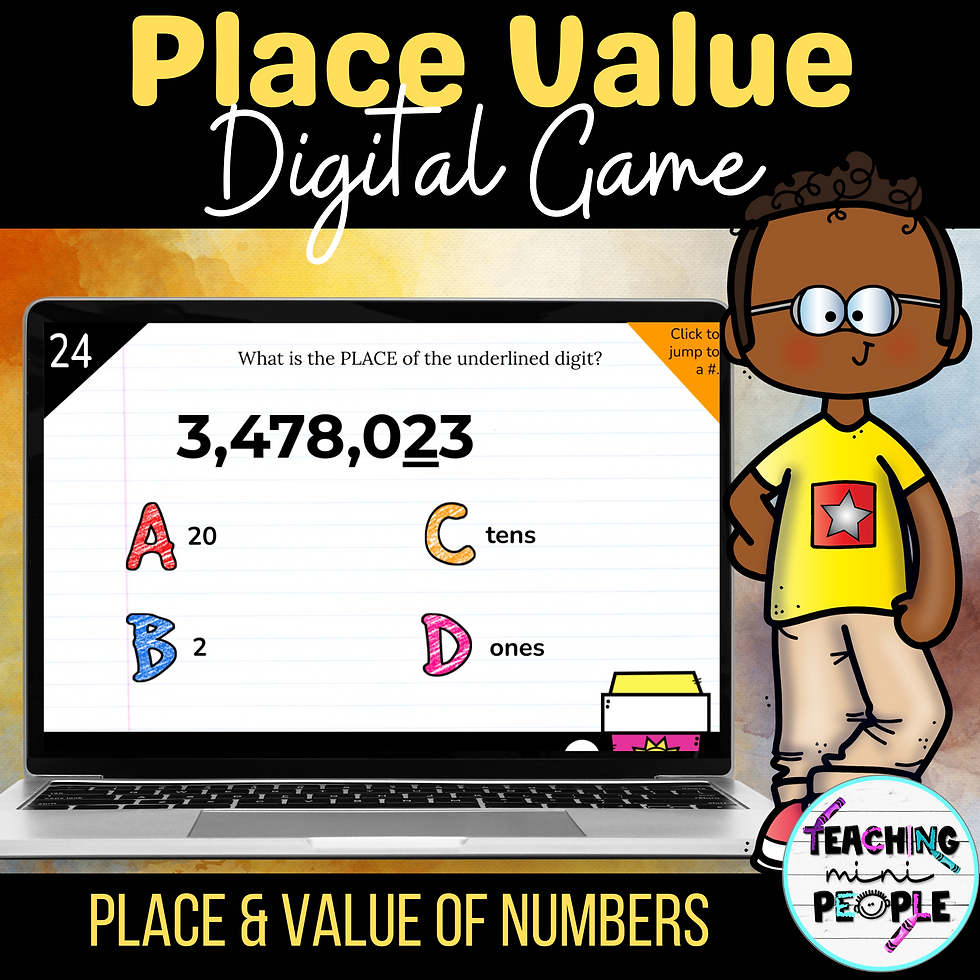3 Focuses for Teaching Place Value
- Kristy Johnson

- Dec 18, 2020
- 3 min read
Updated: Apr 14, 2023

Learning about place value is very important in school, especially in the upper elementary grades. It is best for students to have a concrete understanding of place value and what it means, even when just discussing a simple example of tens and ones so that by the time students are learning about higher numbers in the thousands and above, they have a very clear understanding of place value and what it means. All three of the below focuses are taught in my Place Value Unit Bundle!

Place vs. Value
When teaching about place value, many teachers focus on students’ understanding of where a number falls, ie. ones, tens, hundreds, etc. However, we must also teach students to understand how that place changes the value of each number. Students must understand place vs. value. The place is just where it falls but the value is what that number is worth because of where it falls.
EXAMPLE: 67,893 - The place of the 7 is the thousands place, but its value is 7,000. I have created this digital, self-checking Place Value Game for students to practice this understanding.
10x
In addition to understanding a number’s value, students need to also have a strong understanding of the place value system and that each place is 10x larger as you move to the left. In my classroom, we use this jingle to help remember this- “To the left, to the left, we are 10x bigger to the left.” It is important that students understand that EACH place is 10x larger. Therefore, from the tens to the thousands place, the number is 100x larger. This Ten Times The Number Task Card set is the perfect practiced to fully understand this concept!
EXAMPLE: Compare the 7 in 7,983 to the 7 in 275. A lot of students will say 7,983 is larger than 275. However, this is not what we are looking for. Although that is correct, that is not what the question has asked. They need to understand that the 7 in 7,983 is 100x larger than the 7 in 275.
Rounding
Rounding is great for real-world applications and for students to be able to make connections about numbers. My Rounding Task Card set is perfect for students to continue practicing this skill.
Example - “I have about 700 baseball cards.” We would teach students that when you are discussing a number this high-it is sometimes easier to just round and estimate than to actually count your baseball cards out individually. Give a general estimate that is close.
Another example-”I have about 20 pairs of shoes.” If you know you have MORE than 15 pairs of shoes and LESS than 25 or 30, you can easily round and save time by saying you have about 20 pairs of shoes. Sometimes counting exactly is not always necessary.
Check out all of my Place Value resources here! Most of them were created for 2nd and 4th grade but could also be used for 3rd grade students.
Here are some ways to easily teach your students about rounding:

Base Ten Blocks
Create “rules” with your blocks. When rounding to the tens place, you can only have tens rods (nothing smaller). When rounding to the 100’s place, you can only have 100’s rods. This helps them visualize what it really means to round.
Number Lines
Number lines are great because they give students a better visual for rounding and they can draw them at any time, for any situation.
Songs
After introducing rounding with base ten blocks AND number lines, I then teach this trick: “. 5 or more, raise the score! 4 or less, let it rest.” Then, I have students try to come up with their own saying for this rule to stick in their heads. Whenever I can create a rhyming song or catchy tune to teach something, I definitely do. It will stick with your students more than you think!
In my classroom, I use mastery checks after my lessons to make sure students understand the concept and to form my groups for the following day or week (depending on the skill). Check out these FREEBIE mastery checks! Place Value and Operations
If you love saving time AND money, I have created a FULL Place Value Unit bundle that includes everything I use for teaching my place value unit. The unit lasts 3 weeks and includes everything you need from lessons to task cards to weekly checks! You can find it HERE.







Comments